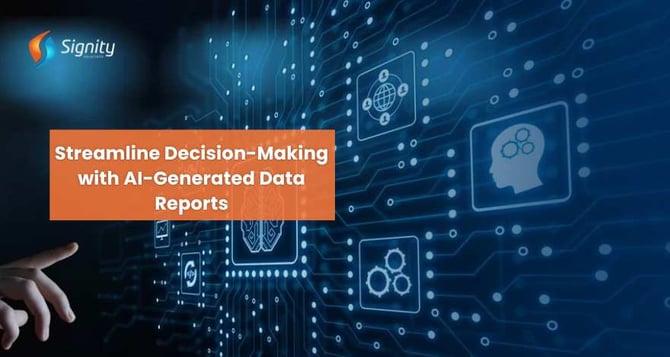Streamline Decision-Making with AI-Generated Data Reports
Unlock unparalleled efficiency in decision-making through AI-generated data reports. Discover how these dynamic documents, powered by advanced AI technologies, offer actionable insights across industries, enhancing accuracy and scalability.

Introduction
In the contemporary landscape of data-driven decision-making, Artificial Intelligence (AI) emerges as a pivotal force, offering not just analysis but also the generation of insightful reports. This article delves into the realm of AI-generated data reports, elucidating their significance and providing practical insights for implementation.
Understanding AI-Generated Data Reports
AI-generated data reports are dynamic documents crafted by AI systems, extracting valuable insights from raw data repositories. Beyond their visual appeal, these reports serve as compasses for decision-makers, streamlining the data analysis process and mitigating the risk of human errors. They transcend industry boundaries, finding utility in finance, marketing, healthcare, and myriad other sectors, synthesizing complex data, and furnishing actionable recommendations.
Ready To Harness The Power of AI-Generated Data Reports?
Contact us today to kickstart your journey towards enhanced decision-making. Our team of experts is poised to assist you every step of the way.
Key Advantages of AI-Generated Data Reports
- Enhanced Efficiency: AI's rapid data processing capabilities expedite report generation, fostering agility in decision-making processes.
- Heightened Accuracy: By minimizing the influence of human errors, AI engenders a higher degree of precision in data analysis and report crafting. Using reporting tools will allow businesses to seamlessly visualize data, automate workflows, and make informed decisions faster.
- Consistency Across Reports: AI ensures uniformity in report format and content, irrespective of data volume, bolstering reliability.
- Scalability: With the capacity to handle extensive datasets, AI-generated reports cater to the needs of organizations at any scale.
- Unveiling Insights: AI possesses the prowess to unearth latent insights concealed within data, transcending conventional analytical methodologies.
How Our Company Empowers You with AI-Generated Data Reports
At Our Company, we specialize in harnessing the potential of generative AI technologies to revolutionize decision-making paradigms. Leveraging cutting-edge advancements in AI development, our team of ChatGPT developers crafts bespoke solutions tailored to your organizational needs. By integrating AI-powered data reporting systems into your infrastructure, we empower you to unlock actionable insights, drive operational efficiency, and stay ahead in today's competitive landscape.
Now, let's dive into some code snippets to demonstrate how to create AI-generated data reports using Python and popular libraries.
Code Snippets for Implementation
1. Data Preparation
Before generating reports, you need to prepare your data. Let's assume you have a dataset in a CSV file named `data.csv`. You can use the `pandas` library to load and manipulate the data:
|
|
2. Data Analysis
Next, you can use libraries like `numpy` and `matplotlib` to perform basic data analysis and create visualizations:
|
|
For an added layer of data manipulation and analysis within your report generation infrastructure, consider leveraging the SpreadJS browser-based spreadsheet. This robust JavaScript solution provides extensive Excel functions and formula capabilities, enabling powerful data process augmentation which can be harmoniously integrated with AI-driven insights to amplify productivity.
3. Report Generation
To generate AI-powered reports, you can use the `ReportLab` library for creating PDF reports:
|
|
4. Machine Learning Insights
To include machine learning-based insights, you can use libraries like `scikit-learn` for model training and prediction:
|
|
90% Faster Decision-Making
Unlock the potential of AI-generated data reports and experience decision-making at 90% faster speeds. Explore how our solutions, powered by ChatGPT and Generative AI, can streamline your processes.
Conclusion
In conclusion, AI-generated data reports herald a new era of decision-making prowess, epitomizing efficiency, accuracy, and scalability. Armed with the insights and code snippets delineated in this article, organizations can embark on a transformative journey towards leveraging AI to augment decision-making efficacy and achieve sustainable growth. As you embark on this journey, remember that our team at Signity Solutions stands ready to collaborate and catalyze your success through innovative AI solutions.


%201-1.webp)


.png?width=344&height=101&name=Mask%20group%20(5).png)







.png?width=352&name=microsofts-recall-feature%20(13).png)








